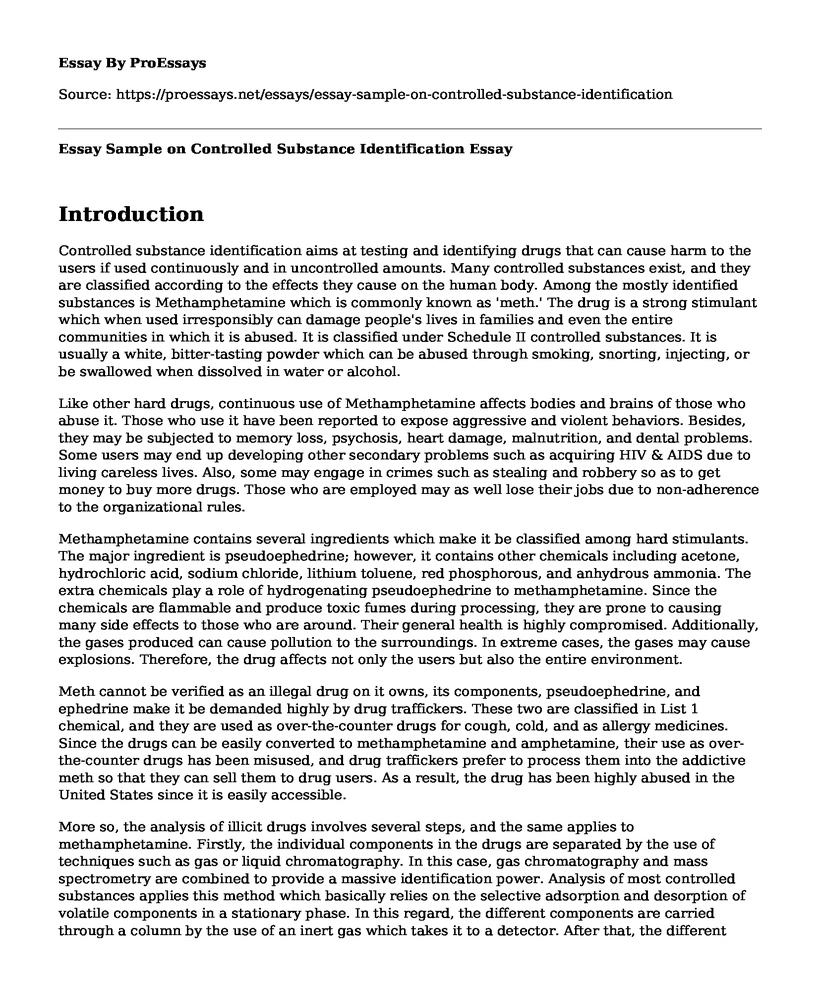Introduction
Controlled substance identification aims at testing and identifying drugs that can cause harm to the users if used continuously and in uncontrolled amounts. Many controlled substances exist, and they are classified according to the effects they cause on the human body. Among the mostly identified substances is Methamphetamine which is commonly known as 'meth.' The drug is a strong stimulant which when used irresponsibly can damage people's lives in families and even the entire communities in which it is abused. It is classified under Schedule II controlled substances. It is usually a white, bitter-tasting powder which can be abused through smoking, snorting, injecting, or be swallowed when dissolved in water or alcohol.
Like other hard drugs, continuous use of Methamphetamine affects bodies and brains of those who abuse it. Those who use it have been reported to expose aggressive and violent behaviors. Besides, they may be subjected to memory loss, psychosis, heart damage, malnutrition, and dental problems. Some users may end up developing other secondary problems such as acquiring HIV & AIDS due to living careless lives. Also, some may engage in crimes such as stealing and robbery so as to get money to buy more drugs. Those who are employed may as well lose their jobs due to non-adherence to the organizational rules.
Methamphetamine contains several ingredients which make it be classified among hard stimulants. The major ingredient is pseudoephedrine; however, it contains other chemicals including acetone, hydrochloric acid, sodium chloride, lithium toluene, red phosphorous, and anhydrous ammonia. The extra chemicals play a role of hydrogenating pseudoephedrine to methamphetamine. Since the chemicals are flammable and produce toxic fumes during processing, they are prone to causing many side effects to those who are around. Their general health is highly compromised. Additionally, the gases produced can cause pollution to the surroundings. In extreme cases, the gases may cause explosions. Therefore, the drug affects not only the users but also the entire environment.
Meth cannot be verified as an illegal drug on it owns, its components, pseudoephedrine, and ephedrine make it be demanded highly by drug traffickers. These two are classified in List 1 chemical, and they are used as over-the-counter drugs for cough, cold, and as allergy medicines. Since the drugs can be easily converted to methamphetamine and amphetamine, their use as over-the-counter drugs has been misused, and drug traffickers prefer to process them into the addictive meth so that they can sell them to drug users. As a result, the drug has been highly abused in the United States since it is easily accessible.
More so, the analysis of illicit drugs involves several steps, and the same applies to methamphetamine. Firstly, the individual components in the drugs are separated by the use of techniques such as gas or liquid chromatography. In this case, gas chromatography and mass spectrometry are combined to provide a massive identification power. Analysis of most controlled substances applies this method which basically relies on the selective adsorption and desorption of volatile components in a stationary phase. In this regard, the different components are carried through a column by the use of an inert gas which takes it to a detector. After that, the different components are identified based on their retention time and mass spectrum.
The chromatography technique has been used in many cases that involve separation of carbon-containing mixtures into separate components by enhancing attraction to the stationary phase while being propelled by the moving phase. In gas chromatography, separation of mixtures is based on their distribution between the stationaryliquid phase and moving gas phase. Most drug analysis companies apply this technique since it is capable of separating components from complex mixtures within a few minutes.
Many attempts have been made to slow down the manufacture of meth so as to reduce its supply to regular users. In 2005, the Combat Methamphetamine Epidemic Act was passed to limit the process by inhibiting access to cold medications that contained pseudoephedrine. As a result, the purchase of over-the-counter pseudoephedrine was regulated such that there was an exact number of times that individuals were allowed to buy such medications in a month. Besides, sellers of those drugs were to keep records of the regular buyers to avoid cases of those buying the drug for illegal purposes. The records were to be kept for about two years so that the buyers can be monitored continuously. The Department of Justice and Drug Enforcement Administration was responsible for this move.
Conclusion
Reports show that the major cause of the increased abuse of meth is the diversion of over-the-counter medications such as pseudoephedrine into the laboratories that manufacture the illegal drug. Since the enforcement agencies face a big challenge in regulating the diversion, an increased number of the United States' resident's access meth and abuse it without considering the side effects that may result. As such, the only way to combat this act is to seize drug to identify pseudoephedrine in them. Those that contain the elements can then be withheld for further investigations.
Cite this page
Essay Sample on Controlled Substance Identification. (2022, Nov 17). Retrieved from https://proessays.net/essays/essay-sample-on-controlled-substance-identification
If you are the original author of this essay and no longer wish to have it published on the ProEssays website, please click below to request its removal:
- Gender Discrimination at Workplaces Essay
- Human Trafficking and Russian Mafia Paper Example
- Bullying in the Work Place Annotated Bibliography
- Essay Sample on Genetics and Alcoholism
- Essay Example on Discrimination in U.S. and Abroad: Pre-Civil War to Present
- Research Paper Sample on PTSD: A Growing Challenge for U.S. Military Personnel
- Essay on Social Media Addiction in the Workplace: Impacts on Productivity, Relationships, and Solutions







